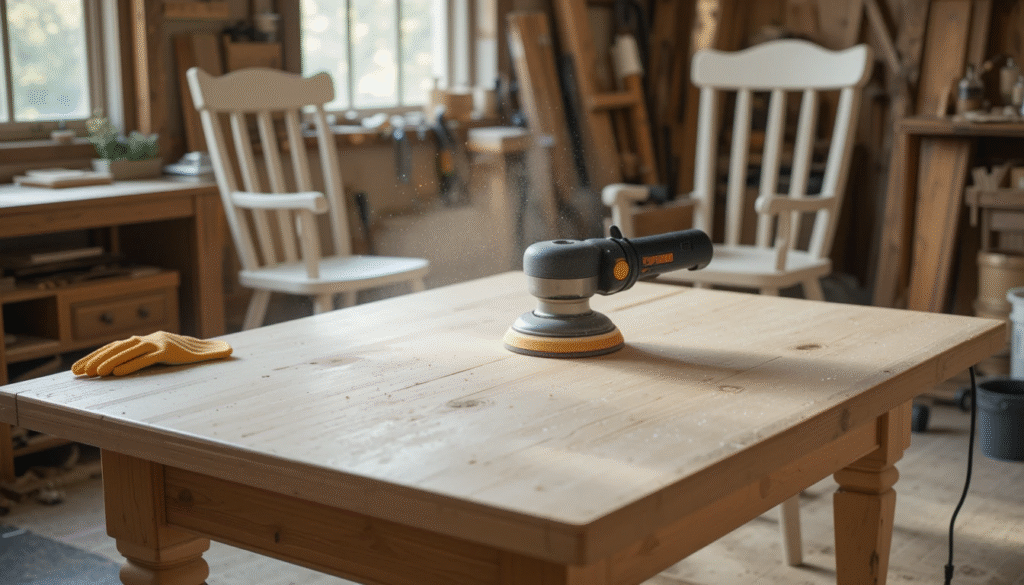Introduction
If you want to give new life to old wooden furniture, then using the right tool and paint is the first step. Nowadays the trend of DIY furniture makeovers is everywhere, but success will be achieved only when you use the best sander for furniture and the best paint for wood furniture without sanding.
In this guide, we will tell you:
✅ Which sander is perfect for your furniture project
✅ Which paint can give a perfect finish even without sanding
Which Sander Is Best for Wood Furniture?
Sanding is essential to make furniture smooth and paint-ready, and each type of sander has its own role:
- Orbital Sander: Best for beginners. Sands in circular motion, easy to handle.
- Palm Sander: Perfect for small surfaces or tight areas. Lightweight and affordable.
- Detail Sander: Ideal for corners and carvings. Pointed tip smooths hard-to-reach places
| Sander Type | Pros | Cons |
| Orbital | Fast, even sanding | Circular marks if the pressure is high |
| Palm | Compact, easy to control | A little slow on large surfaces |
| Detail | Precision sanding | Small surface area, takes time |
Best Sanders for Tables and Large Furniture
When you want to sand a table or large furniture, a single tool is not enough for every surface. It is better to use different tools for flat surfaces and curved surfaces.
Which sander is best for which work?
Table Sander (Random Orbital): If you have a flat table, then this tool is best. Its result is smooth, and there are no swirl marks.
Spindle Sander: This is for those people who want to sand the curved edges of furniture or legs of the table.
Belt Sander: If there is old polish or varnish on a table and you want to remove it, then this is the most powerful and fast option.
Tips:
For curved or narrow areas, a detail sander or hand sanding gives better results.
After sanding, it is important to clean the dust from the surface with a vacuum attachment or brush.
How to control dust during sanding?
While sanding furniture, dust flies everywhere, and if it is not controlled, the finish gets spoiled, and it also affects health. That’s why it’s useful to follow these steps before sanding:
✅ Dust Collection System: Nowadays many sanders come with a built-in vacuum. If you have an external dust collector, even better.
✅ Damp Cloth: After every sanding, the surface should be wiped with a wet cloth.
✅ Ventilated Room: Where sanding is taking place, open a window and turn on a fan.
✅ Seal Off Area: Cover the area with a plastic sheet and masking tape so that the dust doesn’t get onto other things.
What Is the Golden Rule of Sanding Furniture?
Always remember one rule while sanding:
- Always sand with the grain of the wood, not against the grain.
- Start with a low grit like 60 or 80.
- Then gradually move up to a finer grit like 220.
- Don’t try to rush. Sanding is a matter of patience. Sanding done quickly gives an uneven and rough finish.
- Good sanding means your furniture is 100% ready for paint or polish.
Which Grit Sandpaper Is Best for Furniture?
Different grit sandpaper is used for each sanding stage. Below is a simple breakdown:
60–80 Grit: When there is old varnish or paint on the furniture, or the surface is very rough.
120–150 Grit: This is the middle stage in which the surface is made smooth.
220 Grit: For the final touch. This makes the surface silky smooth before painting.
Pro Tip:
Whenever you change the grit, make sure to clean the surface with a dry cloth. Only then will the effect of sanding be complete.
Best Paints for Wood Furniture (Even Without Sanding)
If you want to avoid sanding, don’t worry. Nowadays such paints are also available that do the job without sanding.
What Paint Works Best on Wood Without Sanding?
Chalk Paint: Use chalk paint from brands like Annie Sloan or Rust-Oleum. Gives a smooth finish and does not require prep.
Milk Paint: Gives a natural finish, with a slightly distressed look.
Acrylic Latex Paint: Durable and water-resistant too. Good for daily-use furniture.
Can You Paint Wood Furniture Without Sanding It?
Yes, paint can be done without sanding, but there are some conditions:
✔️ Surface should be smooth and clean
✔️ There should be no peeling or glossy layer
✔️ It is better to use liquid sandpaper or deglosser for adhesion
When is sanding necessary?
- If the wood is damaged
- If there is a glossy layer on the surface
- If multiple paint layers have already been applied
Can You Paint Over Already Painted Furniture?
Yes, you can paint over old paint. But a little preparation is still necessary:
- Lightly sand or scuff the surface so that the new paint can grip
- Use paints that contain both paint and primer (like Behr or Zinsser)
- Make sure to do a small test patch before full paint
Do You Always Need Primer Before Painting?
Primer is not necessary on every surface. Nowadays such paints are available in the market, which come with a built-in primer.
- But you should definitely use primer when:
- The surface is dark or stained
- The texture is uneven
- The surface is glossy and the paint does not stick properly
So take the decision of primer after looking at the surface; every piece of furniture is different.
Conclusion: Best Finish = Right Tools + Right Paint
If you want to give a professional finish to your wooden furniture, then remember only one formula:
✅ Use the best sander so that the surface is properly prepared
✅ Choose a good paint whether you are sanding or not
✅ Sanding strengthens the grip of the paint, and the paint gives the final magic
Pro Tip:
The material of every piece of furniture is different, so do not blindly apply the same process everywhere. First check the surface, then make your plan. Remember, preparation is the reason for 70% of the result.


